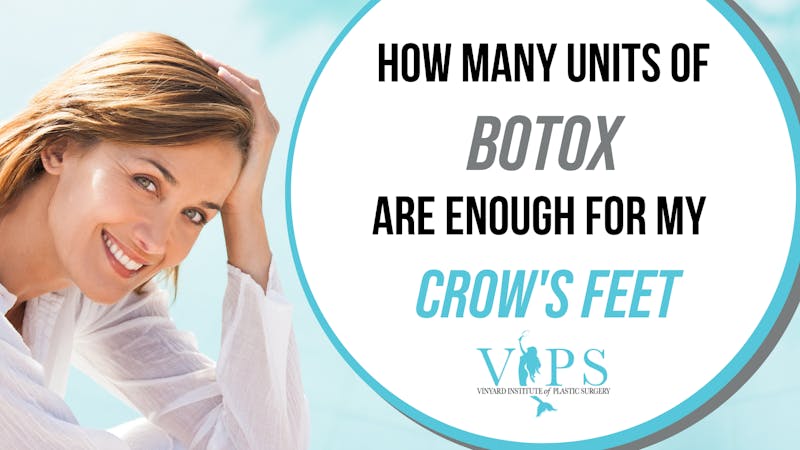Every time we smile, laugh, or furrow our brows in frustration, we engage the use of our facial muscles. This causes the temporary appearance of creases or wrinkles. Over time, some of these creases (specifically those around the external corners of the eye) develop into crow’s feet. While some women insist that their crow’s feet point to their happy disposition and growing wisdom from aging, others are anxious to remedy these visible side effects of aging skin. If you are in the latter category, this article is for you! We will address the causes of crow’s feet, how Botox effectively treats existing wrinkles, and answer the inevitable question: “How many units of Botox do I need for my crow’s feet?”
One of the most prominent signs of aging is the appearance of creases/wrinkles around the eyes; these creases reduce the skins’ tautness and make the skin appear saggy or loose, thereby adding years to the face. The severity of the wrinkles – whether the wrinkles are thin and light or deeper and more defined – determines the treatment plan. Regardless of the extent of anti-aging treatment required, it is imperative to consult with a trustworthy and experienced certified aesthetic injector who will assess the needs of your individual face and recommend the precise injectable and number of units necessary to achieve your personal anti-aging goals. While discussing the best practices of treating crow’s feet with Botox throughout this article, we recommend booking an initial consultation with our team of experts at Vinyard Institute of Plastic Surgery to get a personalized assessment and individualized treatment plan that is unique to your anatomy and goals.
Botox is a highly-effective treatment for aging symptoms such as Crow’s feet!
What Causes Crow’s Feet?
When we are young, our skin is filled with elastin and collagen, which ensure that regardless of how we move our faces to express a range of emotions, they always seamlessly return to their initial, taut resting point as the muscles relax. These elements help keep the skin smooth and wrinkle-free. Over the years, the collagen and elastin proteins gradually break down, and the skin struggles to bounce back as quickly as it previously could, causing the facial muscles to stay contracted. This leads to the gradual formation of fine lines along the brow line, eye creases, and external edges of the eyes, along with the forehead and edges of the mouth. Similarly, a change may be noticeable throughout the cheeks and jawline, as the collagen thins and the face loses its youthful vigor.
In addition to this added stress upon the skin, the eye area, in particular, has the added pressure of the absence of oil-secreting glands to help smooth the thin, inner layer of skin. Consequently, the skin areas surrounding the eyes are more vulnerable than other areas of skin to the effects of aging, wrinkling, and overall drying of the skin.
Some individuals begin to notice the formation of crow’s feet throughout their 20s, while others will not need to start preventative treatment until their 30s.
If you are considering treating your crow’s feet, it is important to consider the environmental factors that play a role in the health of your skin. Ask yourself:
- Are you genetically prone to lighter or more severe wrinkles?
- How much sun exposure has your skin received?
- What does your diet look like? Are you supporting your skin through a vitamin and mineral-rich routine?
- How stressed are you on a daily basis?
- How severe is the pollution in the air in the areas where you spend the majority of your time?
Read more from our blog about the impact each of these factors plays on the health and long-term wellness of your skin. You should also discuss these factors with your injector as discussing your skin’s current quality and appearance as compared to the desired result will help your provider to fine-tune treatment recommendations to your skincare needs and lifestyle.
How to Reduce the Appearance of Crow’s Feet:
Is Botox a Safe Option?
Absolutely! As long as you choose a certified, experienced injector, Botox injections are an extremely safe and minimally invasive procedure while being highly effective for treating facial fine lines and wrinkles. It works by temporarily paralyzing the orbital muscles around the eyes, allowing the muscles to relax and thereby reducing the amount of muscle activity in the area, thus decreasing stress on the skin and, in turn, turning back the clock on your skin.
The FDA Approved the Use of Botox for Crow’s Feet Nearly a Decade Ago
In fact, since being approved by the FDA for the treatment of crow’s feet in 2013, Botox has been touted as the most effective treatment of crow’s feet available in the United States.
How Much Botox Is Needed for Crow’s Feet?
If you have never received Botox treatment before, the terms “a unit of Botox” and “a vial of Botox” may be confusing. Though a fairly arbitrary unit of measurement, in technical terms, a “unit” corresponds to a standard number of botulinum molecules. This particular measurement allows injectors to accurately understand and standardize precisely how much Botox is necessary to fully relax a nerve.
Each “vial” of Botox contains 100 units, which is generally split into treating several areas rather than all 100 units being injected into a single muscle area. For example, it is most common to need 10-12 units of Botox for each eye when treating crow’s feet, which utilizes a total of 20-24 units of Botox. The remaining units of Botox may be used to treat other areas of the face, for example, the frown lines around the eyebrows and nose, the glabellar lines (the horizontal lines on your forehead created by frowning), or the forehead. Botox can also be injected into the masseter muscles (these muscles where you clench at your jawline to help slim and contour the face.
Your precise unit needs will be determined by your injector at your consultation, as factors such as gender, age (read more from our blog about Botox during your twenties and thirties, forties, and fifties and beyond!), metabolism, facial muscle strength, face shape, wrinkle severity, face size, and personal aesthetic goals should all play an important factor in assessing precisely how many units of Botox you will need. If you have any questions, be sure to write them down ahead of time to remember to ask them during your consultation.
Reduce Crow's Feet Wrinkles
Book Your Complimentary Consultation
Picking a Botox Injector: Cues to Pay Attention to Before Receiving Your Crow’s Feet Injections
As always, it’s important to choose a reputable, certified and experienced provider to perform any kind of cosmetic treatment or procedure. After all, you are stuck with your face for life, so valuing your long-term aesthetic goals and trusting your practitioner should always come before saving a few bucks.
The Botox horror stories you may hear about arise when patients opt for the cheapest option with non-certified practitioners operating out of establishments that are not overseen by a Board Certified Plastic Surgeon. At Vinyard Institute of Plastic Surgery, all of our providers are properly certified, highly trained, and overseen by our Board Certified Plastic Surgeon, Dr. William J. Vinyard, MD, FACS. If you are considering Botox injections, remember to look for the following cues from your injector:
- Ask to see the injector’s previous work to ensure that you like the results they have achieved for others with the same treatment.
- Pay attention to whether the injector takes the time to listen to you. Are you able to speak up and ask for what you want? Is the provider paying attention to your personal aesthetic goals? Did she carefully examine your face to identify your individual needs?
- Trust your body: do you feel tense and tight – a sign of anxiety – or relaxed and calm while chatting with your injector? Nerves are natural, but you should never feel distrustful of the provider’s expertise or treatment plan for you. If you do, follow your gut intuition and find another injector who has the necessary credentials and makes you feel comfortable.
More Articles
As you consider your skin rejuvenation goals, Dr. Vinyard and his team of experts wield many options for improving the aesthetic of your skin. A Morpheus8 treatment can be an incredible addition to your treatment plan, and Dr. Vinyard and his team of experts are ready to support you in achieving your aesthetic goals. Contact us to schedule a personal consultation, or call (772) 362-3357 to find out the next steps in your skin rejuvenation journey! Our office at 291 NW Peacock Blvd, Suite 103, Port St. Lucie, FL 34986, proudly serves the South Florida area! We also invite you to check out our blog page, Facebook, and Instagram to learn more about the treatment options available at our office!
by Vinyard Institute of Plastic Surgery | Jun 20, 2023
Say goodbye to invasive procedures and hello to a new era of body sculpting that’s as cool as it sounds! But don’t just take our word for it; let’s dive in to see which celebrities are raving about their CoolSculpting Elite results and how you can benefit from it, too!
by Vinyard Institute of Plastic Surgery | Jun 15, 2023
Let’s break down the differences between CoolSculpting and Emsculpt and why we feel CoolSculpting is the superior option for your body contouring journey!
by Vinyard Institute of Plastic Surgery | May 17, 2023
We’ll compare two of the most popular non-invasive treatments for double chin reduction: CoolSculpting and Kybella. As you embark on your journey to reclaim your jawline and accentuate your facial contours, knowing which treatment is right for you is essential. Let’s break down the science behind these cutting-edge procedures, weigh the pros and cons, and help you make the best choice to enhance your natural beauty!
Read More Articles
Share it!




